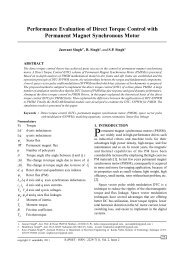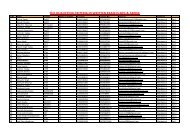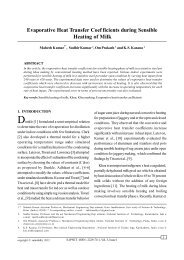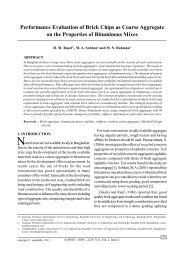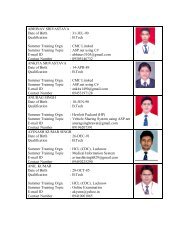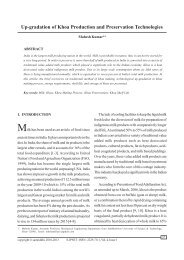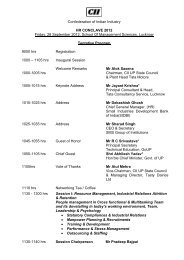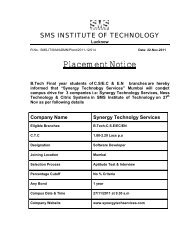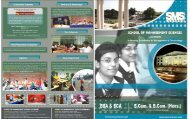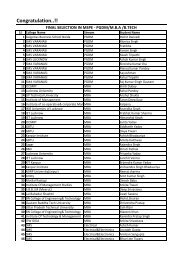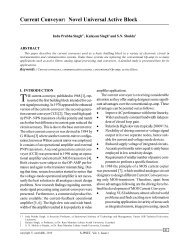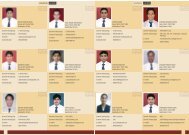Electronics Spectra - SMS Lucknow
Electronics Spectra - SMS Lucknow
Electronics Spectra - SMS Lucknow
You also want an ePaper? Increase the reach of your titles
YUMPU automatically turns print PDFs into web optimized ePapers that Google loves.
<strong>SMS</strong> Institute of Technology, L ucknow<br />
Department of <strong>Electronics</strong> & Co mmunication<br />
swer for them under “any circumstances”.<br />
• Points (upto 5%) may be deducted<br />
from the total points of a<br />
candidate if his/her handwriting is<br />
not easily legible.<br />
• Put in a serious and sincere e f-<br />
fort.<br />
o<br />
Marks are not allotted for<br />
mere superficial knowledge.<br />
Orderly, effective and exact<br />
expression combined with<br />
due economy of words will be<br />
rewarded.<br />
• SI units will be used in the papers<br />
and Candidates should use only<br />
International form of Indian n u-<br />
merals (i.e. 1,2,3,4,5,6 etc.) while<br />
answering question papers.<br />
• The Commission have discretion<br />
to fix qualifying marks in any or all<br />
the subjects of the examination.<br />
o<br />
Quantum mirage<br />
The Objective Type papers will<br />
be evaluated first and evaluation<br />
of the Conventional<br />
type papers is done only for<br />
those candidates who obtain<br />
the minimum qualifying marks<br />
in Objective types papers, as<br />
fixed by the Commission.<br />
• Strongly Prepare general abili ty<br />
Question Paper.<br />
• Solve the previous years Question<br />
Paper.<br />
• Set the timing for every section-<br />
’time is a big key’.<br />
• Solve confidentally.<br />
• Prefer best books.<br />
• Prefer short, confident techniques<br />
for saving time.<br />
• Prepare for interview.<br />
SUGGESTED BOOKS<br />
1. <strong>Electronics</strong> Devices and Circuit &<br />
Analog <strong>Electronics</strong><br />
o Microelectronic circuit –<br />
SEDRA & SMITH.<br />
o Solid State Electronic Devices<br />
– STREETMAN & BANERJEE.<br />
2. Communication System<br />
o Mordern Digital & Analog<br />
Communication – B.P.LATHI.<br />
o Electronic Communication<br />
System – KANNEDYAND<br />
DEVIS.<br />
3. Signal & System – OPPENHEIN &<br />
WILLSKY.<br />
4. Control System – B.S.MANKKE.<br />
5. Electromagnetic Theory<br />
o Elements of Electromagnetic<br />
– SADIKU.<br />
o Antenna & Wave Propagation<br />
– K.D.PRASAD.<br />
6. Digital <strong>Electronics</strong><br />
o<br />
Digital Design – M.MORRIS<br />
MANO.<br />
o Mordern Digital Electronic –<br />
R.P.JAIN.<br />
SUGGESTED WEBSITES<br />
www.upsc .com<br />
www.onestopgate.com<br />
<br />
Priya Srivastava<br />
EC - III year<br />
Since it first appeared on the cover<br />
of Nature in February 2000, th e<br />
“quantum mirage" has featured on<br />
posters, calendars, websites and the<br />
covers of various books and ma gazines.<br />
The image - which was obtained<br />
using a scanning tunnelling microscope<br />
- shows the electronic wave functions<br />
inside an elliptical "quantum corral"<br />
made of cobalt atoms on a copp er<br />
surface. It was created by Har i<br />
Manoharan, Christopher Lutz and Don<br />
Eigler of the IBM Almaden Rese arch<br />
Center in California. In 1990, working<br />
with Erhard Schweizer, Eiger spelt out<br />
the letters "IBM" using 35 xenon atoms.<br />
And three years later, wo rking<br />
with Lutz and Michael Crommie, he<br />
released the first images of the "quantum<br />
corral", which have also been reproduced<br />
in numerous places.<br />
All moving particles have a wavelike<br />
nature. This is rarely significant on<br />
an everyday scale. But in atom ic dimensions,<br />
where distances are measured<br />
in nanometers, moving particles<br />
behave like waves. This phenomenon<br />
is what makes the electron mic roscope<br />
workable. It is of inter est to<br />
researchers in nanotechnology, who<br />
are looking for ways to deliver electric<br />
currents through circuits too small for<br />
conventional wiring. The term quantum<br />
mirage refers to a phenomenon<br />
that may make it possible to transfer<br />
data without conventional elec trical<br />
wiring. Instead of forcing charge carriers<br />
through solid conductors, a process<br />
impractical on a microscopic scale,<br />
electron wave phenomena are made<br />
to produce effective currents.<br />
A quantum mirage is a peculiar result<br />
in quantum chaos. Every system<br />
of quantum dynamical billiards will exhibit<br />
an effect called scarring, where<br />
the quantum probability density shows<br />
traces of the paths a classical billiard<br />
ball would take. For an elliptical arena,<br />
the scarring is particularly pronounced<br />
at the foci, as this is the region where<br />
many classical trajectories converge.<br />
The scars at the foci are coll oquially<br />
referred to as the "quantum mirage".<br />
They are two dimensional struc -<br />
tures built atom by atom (usin g approximately<br />
30-80 atoms) on at omically<br />
smooth metallic surfaces using a<br />
scanning tunneling microscope (STM).<br />
Once the corrals are built, th e STM<br />
can be used to study these nan ometer<br />
scale structures with atomic resolution<br />
in space and better tha n meV<br />
(micro electron Volt) resolution in energy.<br />
The data of the STM can be<br />
rendered in false color to pro duce<br />
breathtaking images that reveal standing<br />
wave patterns of coherent electrons<br />
inside the corrals.<br />
The presence or absence of a<br />
quantum mirage might be used t o<br />
represent one bit of data in a region<br />
far smaller than any current electronic<br />
device can manage. It has the potential<br />
to enable data transfer within future<br />
nano-scale electronic circuits so<br />
small that conventional wires do not<br />
work.<br />
IBM scientists are hoping to use<br />
quantum mirages to construct atomic<br />
scale processors in the future.<br />
<br />
21 <strong>Electronics</strong> <strong>Spectra</strong>, 2010



